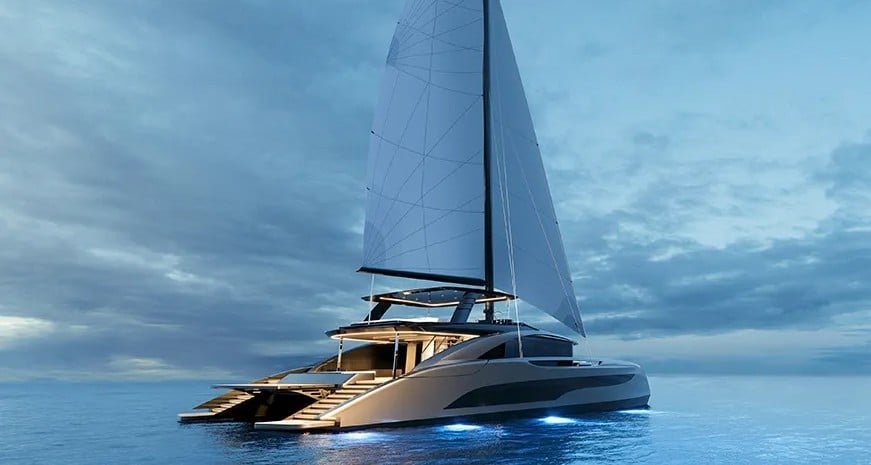Sunreef Yachts gave seafarers a better look at its revolutionary Zero Cat concept, a catamaran that sails on hydrogen and produces its own power.
Sunreef Yachts is leading the market for semi-custom luxury catamarans while establishing itself as a key player in eco-friendly and sustainable yachting. The Polish yard first teased sailors with its hydrogen and solar powered catamaran last July.
Carbon-Free Luxury Sailing
Yachts have long been the symbols of the luxurious lifestyle of the rich and wealthy. But as concerns about climate change continue to intensify, questions arise on how yachts impact the environment.
A superyacht like the Zero Cat is usually defined as a privately owned vessel with at least 78 feet in length. And there are over 9,300 of these vessels sailing on the oceans that’s valued at more than $54 billion.
Along with ships, superyachts contribute significantly to carbon dioxide emissions, which are often overlooked as they’re released at sea.
According to industry data, a superyacht emits more than 7,000 tonnes of CO2 a year – considering it has a helicopter pad, pools, and submarines. To put that in perspective, the emission is over 1,500x more than how much a family car emits.
With this data, maritime construction yards are also put under the spotlight by environmentalists to do something about their pollution.
Sunreef acted fast by introducing its revolutionary superyacht concept – the Zero Cat. It just released the first renders of this highly awaited multihull.
The concept yacht has stairways at the back of each hull, leaning toward the water, and a wraparound lounge at the outside helm. It also appears to have an alfresco lounge.
With this sleek superyacht design, Sunreef’s goal is to develop a sustainable sailing yacht with self-sufficient and unlimited range non-sail propulsion.
At the heart of this zero-emission luxury catamaran is the green energy that sets it apart from other superyacht models.
Zero-Emission and Safe Hydrogen Fuel Cell
According to the yard, Zero Cat runs on an engine that uses a hydrogen fuel cell which powers the superyacht. It also comes with a reformer that can transform methanol into hydrogen.

The fuel-cell system producing clean energy will electrically power the propulsion as well as the hotel load, Sunreef said. With this green technology, the catamaran will generate no carbon emissions and oxides.
Without an engine powered by burning oil, the superyacht will also sail with little noise and vibrations for a quiet and smooth ride.
What’s more unique about Zero Cat is its ability to create additional green energy through its hydro generators and solar cells, which Sunreef refers to as a “solar skin”.
The solar skin is not unique to the concept yacht but has been on Sunreef’s other models. It’s wrapped around the superyacht’s bodywork and can continuously produce solar energy so long as the sun shines.
There’s also a bonus in sailing with Zero Cat: no need for high-pressure hydrogen storage on board. It means yachting would be safe, as opposed to the hydrogen stigma created by the 1937 Hindenburg crash.
And that stigma seems to be erased now that hydrogen fuel cells are hitting the market big time.
Not only is the hydrogen-powered system getting attention in maritime but is also gaining traction in road fleets.
A leading company focusing on zero-emission vehicles, First Hydrogen Corp., shocked the market with its unbeatable fuel-cell EV (FCEV) trial results. The company’s FCEV vans trial with SSE Plc cleared 630km of range, almost double that of traditional EVs. The hydrogen vehicles also boast a 5-minute refuel time, similar to gas-powered vehicles.
With its massive success in the first trial, First Hydrogen will open up fleet trials to additional commercial opportunities. This is in response to growing interests from parcel delivery or logistics companies wanting First Hydrogen’s FCEV for express deliveries. These operation trials will start soon late Qtr 3 and Qtr 4 this year.
The demand for zero-emission vehicles and vessels has started to spike as governments and companies worldwide are racing to net zero emissions. And hydrogen fuel cells offer a promising solution for a cleaner and greener power source.
Sunreef Yachts still has a lot to do before its Zero Cat concept becomes a real superyacht sustainably sailing. But by combining hydrogen energy and other renewable power sources on board the yacht, it holds the promise for a luxurious but carbon-free getaway on the sea.
Disclosure: Owners, members, directors and employees of carboncredits.com have/may have stock or option position in any of the companies mentioned: FHYD
Carboncredits.com receives compensation for this publication and has a business relationship with any company whose stock(s) is/are mentioned in this article
Additional disclosure: This communication serves the sole purpose of adding value to the research process and is for information only. Please do your own due diligence. Every investment in securities mentioned in publications of carboncredits.com involve risks which could lead to a total loss of the invested capital.
Please read our Full RISKS and DISCLOSURE here.
Credit: Source link
